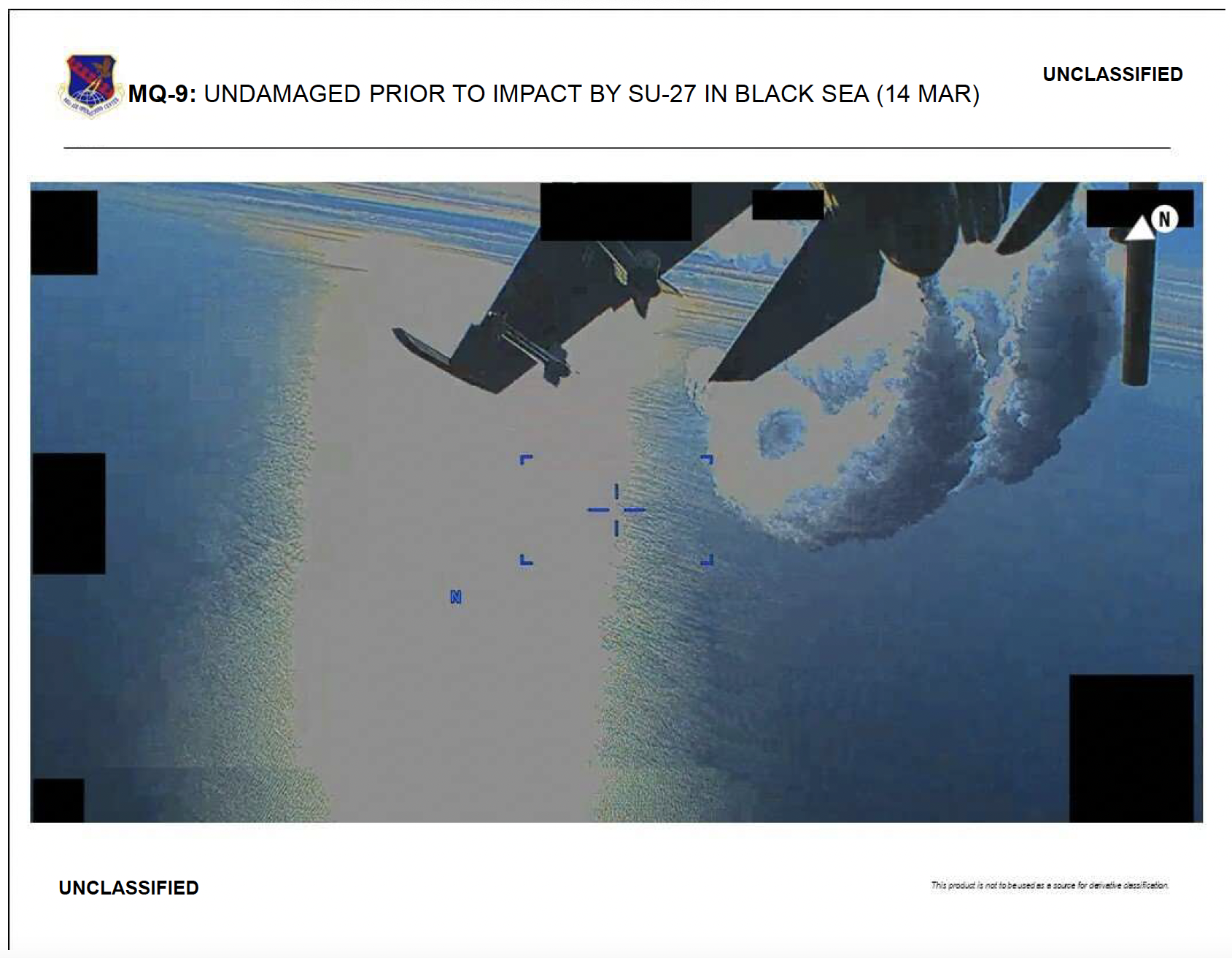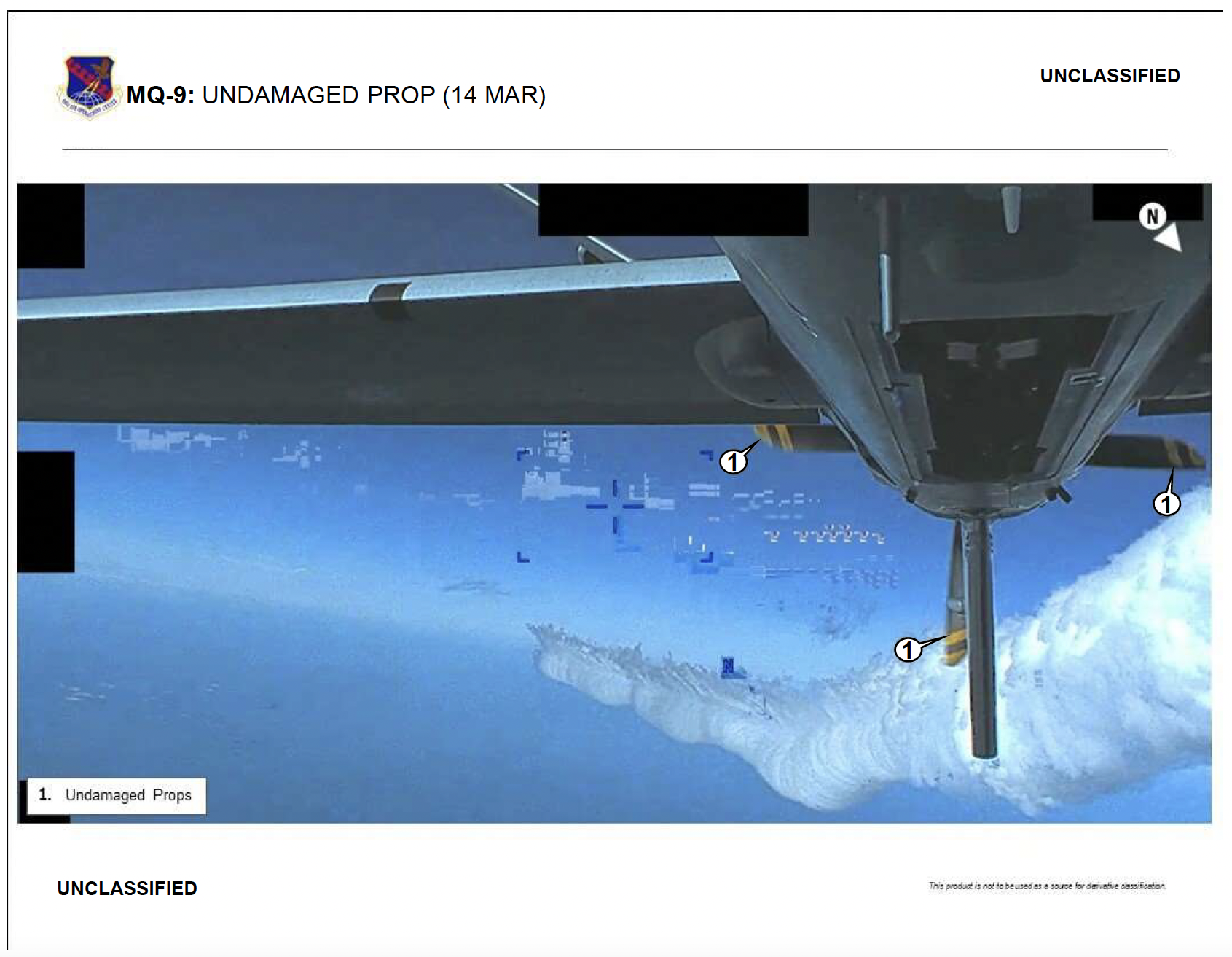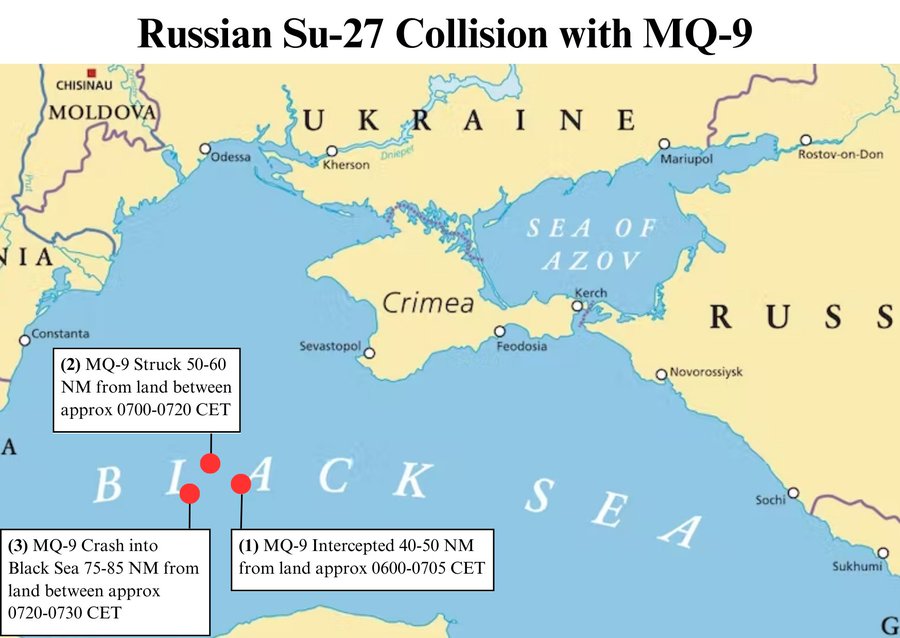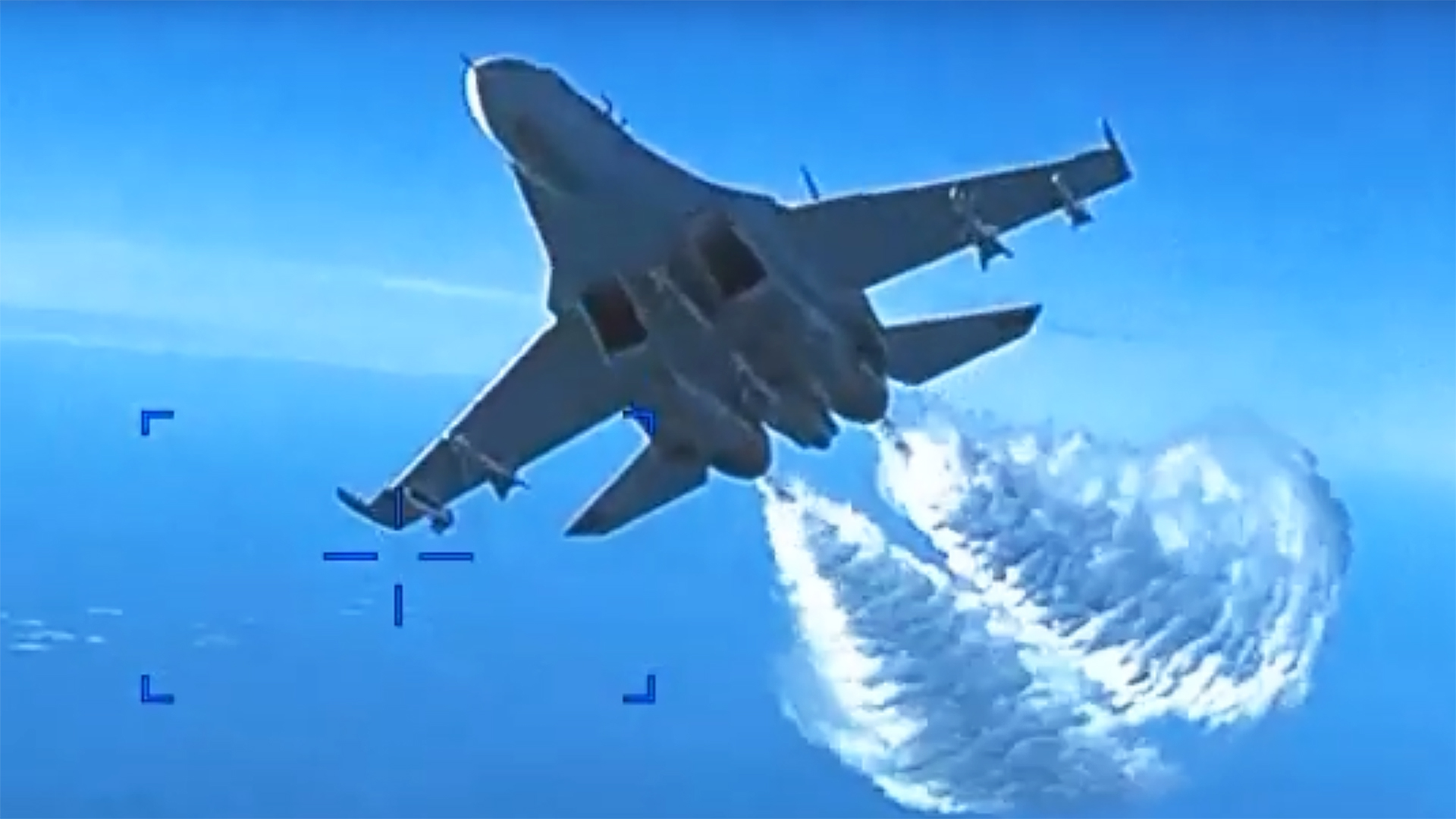The U.S. Department of Defense has released a video showing part of the encounter between a U.S. Air Force MQ-9 Reaper and two Russian Su-27 Flanker fighter jets over the Black Sea on March 14 that resulted in the drone being lost. This seems to confirm that one of the Su-27s struck the drone’s propeller, although it remains unclear to what degree that action was deliberate or a misjudgment.
Readers of The War Zone can get fully up to speed on what is known about this incident in our initial reporting here as well as our analysis of a video that was purportedly shot from the cockpit of one of the two Su-27s here.

The newly declassified video has been edited for length, running 43 seconds. As expected, the footage is from the MTS-B sensor ball below the nose of the MQ-9, which was looking behind the drone as the Su-27 approached it. Approaching from the right-hand rear quarter, the Russian fighter begins dumping fuel, which U.S. officials had already said was one of the more aggressive maneuvers performed by the jet.

On its second approach to the drone, the Flanker — armed with at least six air-to-air missiles — gets even closer, before the video feed is apparently lost. As a result, the moment at which the Su-27 purportedly struck the drone’s propeller is very hard to see. The Pentagon has provided a still (seen below) of the moment of impact but, again, it’s hard to determine exactly what part of the Flanker hit the drone.

Once the video briefly resumes, one of the MQ-9’s four propeller blades clearly appears to be damaged, indicative of an impact with some part of the Su-27. No other damage is apparent, at least from this angle:


The Pentagon had previously stated that the Su-27s dumped fuel on and flew in front of the MQ-9 several times before the collision, “flying in a reckless, environmentally unsound, and unprofessional manner. This incident demonstrates a lack of competence in addition to being unsafe and unprofessional.”
Furthermore, U.S. Air Force Gen. James B. Hecker, the commander of U.S. Air Forces Europe and Air Forces Africa said that “this unsafe and unprofessional act by the Russians nearly caused both aircraft to crash.” The damage sustained by the Su-27 that impacted the MQ-9 remains unclear, but even if it only contacted one of the drone’s propellers it’s likely to have been not insignificant, although clearly not bad enough to prevent it from recovering to an airbase.
That the officially released Pentagon video of the incident has appeared now is not a surprise, with Pentagon spokesman Pat Ryder having said on the day it happened that the U.S. Department of Defense was working to declassify imagery recorded from the MQ-9.
While it’s hard to draw firm conclusions about the degree to which the Russian pilot intended to bring down, or otherwise inflict damage upon the MQ-9, the footage clearly seems consistent with U.S. accounts of “an unsafe and unprofessional intercept.”
At the same time, the video does not support the Russian Ministry of Defense’s account of the incident, which claims that there was no collision at all and that the MQ-9 maneuvered sharply before apparently entering uncontrolled flight and falling into the Black Sea.
We will continue to update this story as more information becomes available.
Update – 7:00 A.M. PST: U.S. Europe Command (EUCOM) has released this official breakdown of what can be seen in the Pentagon intercept video at the top of this article:
00:00: [Start of video] A Russian Su-27 approaches to the rear of the U.S. Air Force MQ-9.
00:05: A Russian Su-27 begins to release fuel as it passes.
00:09 A Russian Su-27 passes over the U.S. Air Force MQ-9 while releasing fuel. As the Su-27 passes over the top of the MQ-9, it also disrupts the video transmission.
00:11: The propeller of the U.S. Air Force MQ-9 can be seen and remains undamaged.
00:22: A Russian Su-27 begins a second approach toward the MQ-9.
00:26: A Russian Su-27 begins to release fuel on the approach toward the MQ-9. An Su-27 proceeds to pass even closer.
00:29: A Russian Su-27 collides into the MQ-9 and the MQ-9’s camera feed is lost for approximately 60 seconds.
00:39: The MQ-9’s camera feed has returned to working order. At this time the propeller can be seen again and one of the props can be seen damaged.
00:42: [End of video]
We now also have some more details of Russian plans to try and recover the wreckage of the MQ-9.
“I don’t know if we can recover [it] or not, but we will certainly have to do that, and we will deal with it,” said Nikolai Patrushev, the secretary of Russia’s security council. “I certainly hope for success,” he added.
U.S. officials have downplayed the risk of sensitive technology falling into Russian hands, saying that debris is lying in such deep water that recovery could be impossible, or would otherwise yield little in the way of intelligence value.
Previously, the director of the Russian Foreign Intelligence Service, or SVR, Sergey Naryshkin, suggested that Russia had the “technical capabilities” to recover the wreckage of the drone from the seabed. This process could potentially be made easier by the rumored location of the impact site, in international waters off the west coast of Russian-occupied Crimea.
However, with Turkey having blocked access for warships in and out of the Black Sea via the Bosphorus and Dardanelles straits, Russia (or the U.S. Navy, for that matter) may not be able to bring to the area the kinds of deep-sea recovery vessels that might be required.
Update – 7:30 A.M. PST: The pro-Russian ForPost news site, which primarily covers Russian-occupied Crimea, has reported that the Russian Navy has found the wreckage of the MQ-9 “near Sevastopol” at a depth of around 900 meters (2,952 feet).
An unnamed source, said to be close to the Russian Ministry of Defense, is said to have told ForPost: “An underwater robot descended to the bottom of the sea, which discovered the MQ-9 Reaper at a depth of about 850-900 meters. Not far from this zone is the deep-water branch of the South Stream gas pipeline.”
The same article claims that a recovery plan is now being put together by the Russian military, which will make use of the kinds of deep-submergence rescue vehicles normally used in submarine accidents.
These claims have not been independently verified.
As to the location of whatever is left of the MQ-9, U.S. Air Forces Europe and Air Forces Africa have now published a map indicating the final movements of the drone. According to this, the MQ-9 was intercepted by Su-27s at around 4-50 nautical miles from Crimea, before being struck at a distance of around 50-60 nautical miles from land. It then crashed into the Black Sea approximately 75-85 nautical miles from land, at around 7:20-7:30 A.M. CET.

Even before that map was released, observers were making their own efforts to try and determine the location of the drone as seen in the Pentagon video, also placing it off the southwest coast of Crimea.
Update – 2:09 P.M. PST:
Pentagon Press Secretary John F. Kirby held a press briefing today where he discussed the newly released footage of the MQ-9 incident. He mentioned that there has been no conversation between the U.S. and its Russian counterparts, that he is aware of, since the release of the video.
“I wouldn’t be surprised if there was none,” Kirby said. “The video is pretty darn conclusive about what happened. It absolutely just decimates the Russian lie about what they said that happened or what they said didn’t.”
When asked about the decision-making process behind the release, Kirby said that he believes the Pentagon was transparent in that respect.
“[We were transparent] that there was imagery associated with this,” said Kirby. “And that we were working our way through that imagery to make sure it was appropriate for product release. And that it clearly demonstrated our narrative of what happened — and I think if any of you have seen that video — you can see clearly that it does. It is not uncommon at all for us to release imagery of these intercepts. We’ve done it plenty of times before. To lay bare and to make clear to the rest of the world the manner in which the Russians have been just flat-out lying about their accounts.”
“So, it was in that vein that we, in keeping with best practices, laid out that imagery,” Kirby added. “But we did want to take the proper amount of time to make sure that the imagery was suitable for public release and in releasing if we weren’t releasing content that might put our own operational security at risk or our ability to collect intelligence. And number two, that it was clear and convincing evidence of the account that we laid out there and, of course, it did. So, now it’s out there.”
The press secretary was also asked if there were any concerns about Russia trying to frame the crash as a “Russia versus U.S.” conflict.
“In terms of whether or not we think that the Russians intercepted [the MQ-9] aggressively enough to escalate or realize Putin’s anti-rhetoric, which he has been spouting since the beginning of the war, that this is really about the West versus Russia, I’m certainly in no position to speak for the Russian Ministry of Defense or their motivations,” Kirby said.
Kirby then made it clear that this isn’t the first intercept of U.S. drones in that airspace.
“It’s happened before, it’s not uncommon for them to intercept, but it was clear that it was aggressive flying, reckless flying … It is not clear to us that the pilots intended to strike the drone. At best it’s reckless, one, and at worst it’s reckless and incompetent … The last thing I’ll say on this is we do not, and we have made clear on many occasions, that we do not see a conflict with Russia,” Kirby said.
U.S. Central Command Commander Gen. Erik Kurilla made similar comments about the footage today when speaking to the Senate Armed Services Committee. Kurilla was quoted as saying that the U.S. has seen an increase in the unsafe and unprofessional behavior of the Russian Air Force as of late, noting that there has been a spike over Syria specifically since March 1.
According to Kurilla, there have been a number of Russian flights over U.S. bases in the region using ground-attack aircraft armed with weapons.
Others have also called out the hazardous nature of the Russian Su-27 pilot’s maneuvers in the declassified footage. A-10 Warthog pilot Dale Stark on Twitter even noted that the video would suggest the Russian aviator in the cockpit could have been an inexperienced student pilot.
Kirby was later asked by a reporter if he could provide details about where exactly the drone went down. He explained that he couldn’t offer any information beyond the map that the Pentagon has since released, but assured that it was in international waters.
He also didn’t go into any detail about what the MQ-9 was surveilling at the time, saying, “I think you can understand why I’m not going to talk about the specifics of our intelligence, surveillance, and reconnaissance collection capabilities or what we’re doing. I can sell you broadly speaking that we have been and are and will continue these ISR flights in support of our broader national security interests in the Black Sea region, and in support of Ukraine and their ability to defend itself.”
As for the map released by the Pentagon reportedly showing the location of the MQ-9’s wreckage included in this article above, it would seem now that independent defense analysts are having a difficult time crosschecking the site near Crimea provided with geolocation attempts made using the footage.
The U.S. also now believes that Russia has already recovered fragments of the downed MQ-9, according to CNN. The pieces have been described as fiberglass or “small bits” of the drone.
Contact the author: thomas@thedrive.com
